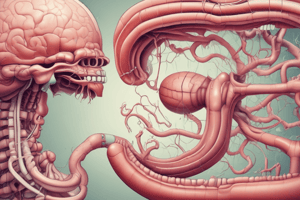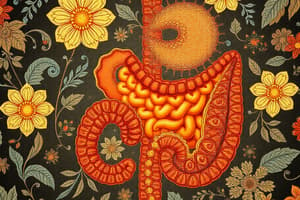Podcast
Questions and Answers
What is the primary neurotransmitter involved in the stimulation of gastric glands during the cephalic phase?
What is the primary neurotransmitter involved in the stimulation of gastric glands during the cephalic phase?
- Dopamine
- Norepinephrine
- Acetylcholine (correct)
- Serotonin
Which phase of gastric secretion is primarily inhibitory?
Which phase of gastric secretion is primarily inhibitory?
- Gastric phase
- Cephalic phase
- Intestinal phase (correct)
- Basal phase
What stimulates the secretion of gastrin in the gastric phase?
What stimulates the secretion of gastrin in the gastric phase?
- Increased acidity in the stomach
- Release of secretin
- Presence of carbohydrates in the stomach
- Distention of the stomach by food (correct)
What is the main effect of increased parasympathetic activity during the gastric phase?
What is the main effect of increased parasympathetic activity during the gastric phase?
Which substance is secreted in an inactive form and requires activation in the small intestine?
Which substance is secreted in an inactive form and requires activation in the small intestine?
The primary function of cholecystokinin (CCK) in the gastrointestinal tract is to:
The primary function of cholecystokinin (CCK) in the gastrointestinal tract is to:
Which mechanism is primarily used by glucose to cross the apical membrane of enterocytes?
Which mechanism is primarily used by glucose to cross the apical membrane of enterocytes?
What is the effect of high acidity (high HCl) on the activity of digestive enzymes?
What is the effect of high acidity (high HCl) on the activity of digestive enzymes?
Which nutrient is primarily absorbed in the jejunum?
Which nutrient is primarily absorbed in the jejunum?
Which process is involved in the transport of fats from enterocytes into the lymphatic vessels?
Which process is involved in the transport of fats from enterocytes into the lymphatic vessels?
Flashcards
Parasympathetic effect on gastric motility
Parasympathetic effect on gastric motility
Increased parasympathetic activity leads to enhanced gastric motility and secretion.
Gastric phase stimuli
Gastric phase stimuli
Stomach distention and food protein stimulate gastrin secretion.
Intestinal phase effect
Intestinal phase effect
Decreased parasympathetic activity slows gastric secretion and motility, triggered by intestinal hormones.
Cephalic phase stimulation
Cephalic phase stimulation
Signup and view all the flashcards
HCl activation of pepsinogen
HCl activation of pepsinogen
Signup and view all the flashcards
Secretin, CCK effect
Secretin, CCK effect
Signup and view all the flashcards
Pancreatic proteolytic enzyme activation
Pancreatic proteolytic enzyme activation
Signup and view all the flashcards
Chylomicron formation
Chylomicron formation
Signup and view all the flashcards
Nutrient absorption methods
Nutrient absorption methods
Signup and view all the flashcards
Bile's role in fat digestion
Bile's role in fat digestion
Signup and view all the flashcards
Study Notes
Gastric Function and Regulation
- Parasympathetic Activity and Gastric Function: Increased parasympathetic activity stimulates gastric motility and secretion. Conversely, decreased parasympathetic activity reduces these processes.
Gastric Secretion Phases
-
Cephalic Phase: Parasympathetic stimulation (acetylcholine) triggers secretion of HCl and pepsinogen from gastric glands. Pepsinogen is activated by HCl in the stomach lumen.
-
Gastric Phase:
-
Increased parasympathetic activity further boosts secretion and motility.
-
Stomach stretching (distention) by food and food proteins stimulate gastrin release.
-
Gastrin then stimulates gastric glands, enhancing secretion.
-
Intestinal Phase (Enterogastric Reflex): This phase is inhibitory. Decreased parasympathetic activity and thus reduced gastric function occurs. Secretin and CCK are secreted in response to chyme entering the small intestine. These hormones, influence gastric function and pancreatic juice secretion.
Chemical Digestion
- Carbohydrates: Salivary amylase starts carbohydrate digestion.
- Proteins: Pepsin digests proteins.
- Pancreatic Enzymes: Amylase digests carbohydrates, lipase digests fats, trypsin digests proteins. Pancreatic proteolytic enzymes are secreted in inactive forms and activated in the small intestine.
- Acidity and Alkalinity: Enzyme activity depends on the pH environment (high HCl for pepsin, high bicarbonate for pancreatic enzymes).
Bile and Fat Digestion
- Bile aids in fat digestion and absorption.
Nutrient Absorption
- Jejunum & Ileum: Nutrients (carbohydrates, amino acids, fats) are absorbed.
- Absorption Mechanisms:
- Glucose and amino acids use secondary active transport across the apical membrane.
- Glucose, amino acids, and fats move from enterocytes into the blood or lymphatic vessels via facilitated diffusion or exocytosis.
- Chylomicrons are formed for fat transport.
Studying That Suits You
Use AI to generate personalized quizzes and flashcards to suit your learning preferences.
Description
Test your knowledge on the intricacies of gastric function and regulation. This quiz covers the roles of parasympathetic activity, the phases of gastric secretion, and hormonal influences on digestion. Challenge yourself to understand how these components work together in the digestive system.




